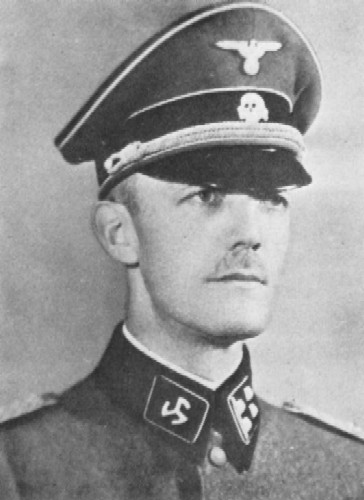Langemarck Trifo's
Just like with other foreign volunteer units, the Germans designed and produced special insignia for these soldiers. The collar tab features an embroidered three-legged swastika, known as the Sonnerad, in silver thread on black wool. It also has the classic light brown buckram backing. Flemish soldiers of Langemarck wore this Trifos alongside the standard SS runes.
Among the Flemish volunteers in the Sturmbrigade Langemarck, two different Trifos collar tab models were in use: the RZM model and the Dachau model. In reality, there were more than just two variants, but for the sake of simplicity, I will discuss the two most common ones.
The RZM model was the first version to be used and appeared in photographs as early as the beginning of 1943 with the Flemish Legion, just before the establishment of the Sturmbrigade Langemarck. The Dachau model was a later variant, which was likely introduced around early-1944 and was produced and worn until the end of the war. This model can be seen in late-war photographs from approximately mid-1944 until the end of the war in May 1945.
The Dachau model primarily appears in photographs from late 1944, which coincides with the establishment of the foreign SS volunteer divisions, including the Langemarck Division. In contrast, the RZM model is more commonly seen in photographs from early to mid-1943 and early 1944.
A Brief History of the Use of the Sonnerad as a Collar Tab
The Flemish were not the only ones to wear the Sonnerad (Trifo) as a collar tab during World War II. Between 1941 and 1942, the Trifo was also worn for a short period by the Danish volunteer battalion Freikorps Danmark, a unit that fought on the German side on the Eastern Front.
On the right, we see a photo of SS-Obersturmbannführer Christian Peder Kryssing, who commanded the Freikorps Danmark from July 19, 1941, to February 23, 1942. However, since very little is known about the use of the Trifo by this unit, I will not delve further into this here. (1)
With the increasing recruitment of non-Germans into the Waffen-SS after 1940, Himmler became concerned about the use of the SS runes by those who were not racially suitable for full SS membership. He therefore insisted that these recruits should wear a unique collar tab without the SS runes. The Germans then designed a series of appropriate collar tabs for their foreign volunteers. (2)
The Trifo was very rarely worn by the Flemish Legion in early 1943, shortly before the establishment of the Sturmbrigade Langemarck. After the formation of the Sturmbrigade Langemarck (May-August 1943), the Trifo collar tabs became increasingly common, alongside the regular SS runes.
German SS officers and non-commissioned officers serving in foreign units still had the right to wear the SS rune collar tabs. Furthermore, starting in 1944, when the foreign SS volunteer divisions were established, the unique collar tabs for these units became mandatory. Despite the requirement, we still see Flemish volunteers at the end of the war wearing SS runes instead of only the Trifo collar tab.

Dachau-Style Trifo
The Dachau-style Trifo was worn from mid/late 1944 until the end of the war in 1945. This type of Trifo was discovered in 1945, together with various other SS insignia, in the SS-BW Depot in Dachau. Since these Trifo pieces all display the same characteristics as the other SS collar tabs from Dachau, they became known as the "Dachau-style Trifo."
Most Dachau Trifos on the market are in mint condition, as they almost certainly originate from the Dachau depot. This depot was looted by American soldiers in April 1945, with many insignia taken as souvenirs. Despite their often unworn state, Dachau Trifos were indeed used during the war. Numerous original photographs show Flemish soldiers wearing a Dachau-style Trifo, and even worn examples are known to exist in collections.
Unlike the RZM model, the Dachau model was used exclusively by the Sturmbrigade Langemarck and later the Langemarck Division, and not by other German units.
